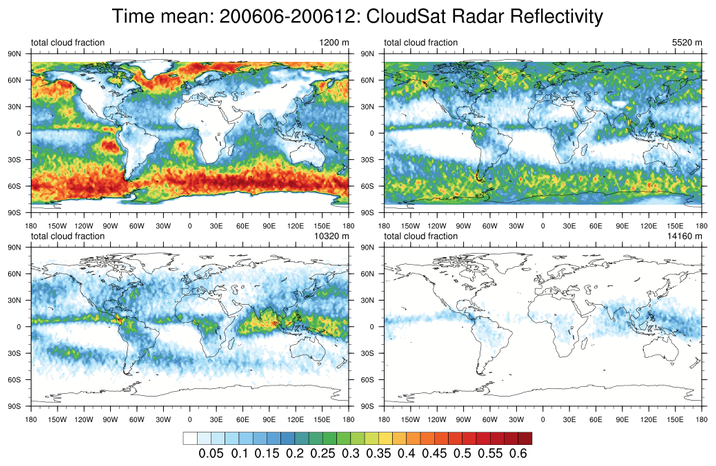NCL Home>
Application examples>
Data sets ||
Data files for some examples
Example pages containing:
tips |
resources |
functions/procedures
NCL Graphics: CloudSat: Cloud Vertical Structure

CloudSat
is a satellite mission designed to measure the vertical structure of clouds
from space. The radar data produces detailed images of cloud structures
which will contribute to a better understanding of clouds and climate.
CloudSat along with
CALIPSO,
Aqua,
PARASOL, and
Aura form a satellite
constellation known as the A-Train. The satellites fly in a nearly
circular orbit with an equatorial altitude of approximately 705 km.
The orbit is sun-synchronous, maintaining a roughly fixed angle between
the orbital plane and the mean solar meridian. CloudSat maintains a
close formation with Aqua and a particularly close formation with
CALIPSO, providing near-simultaneous and collocated observations
with the instruments on these two platforms.
(Note that PARASOL was maneuvered to leave its position inside the A-Train on December 2, 2009.)
The CFMIP-OBS
(Cloud Feedback Model Intercomparison Program) has designed a protocol to evaluate clouds in climate and weather prediction models based on satellite observations.
The 2B-CLDCLASS documentation is
NCL, Matlab, IDL and Python examples
which includes both scripts and the created graphical images.
They also provide NCL specific comments.
This site is updated so CloudSat examples may be added in the future. Please check.
2B-CLDCLASS
Source: http://www.cloudsat.cira.colostate.edu/ICD/2B-CLDCLASS/2B-CLDCLASS_PDICD_5.0.pdf
Table 5. File Specification for 16-Bit cloud scenario
16 Bit Cloud Scenario File Specification
Bit Field Description Key Result
0 Cloud scenario flag 0 = not determined
1 = determined
-------------------
1-4 Cloud scenario 0000 = No cloud
0001 = cirrus
0010 = Altostratus
0011 = Altocumulus
0100 = St
0101 = Sc
0110 = Cumulus
0111 = Ns
1000 = Deep Convection
-------------------
5-6 Land/sea flag 00 = no specific
01 = land
10 = sea
11= snow (?)
-------------------
7-8 Latitude flag 00 = tropical
01 = midlatitude
10 = polar
-------------------
9-10 Algorithm flag 00 = radar only
01 = combined radar and MODIS
-------------------
11-12 Quality flag 00 = not very confident
01 = confident
-------------------
13-14 Precipitation flag 00 = no precipitation
01 = liquid precipitation
10 = solid precipitation
11 = possible drizzle
-------------------
15 Spare


 cloudsat_1.ncl
cloudsat_1.ncl:
(1) Average "CloudSat Radar Reflectivity" over the period 200606-200612
at user specified levels; (2) Radar reflectivity in the vertical at user
specified (lat,lon) locations; (3) User specified cross sections.
The last cross section uses
linint2_points_Wrap to interpolate
to a series of arbitrary points. The
gc_latlon
is used to generate the points on a great circle path.
The file used in this example was obtained from:
ftp://ftp.climserv.ipsl.polytechnique.fr/cfmip/CloudSat/CloudSat_Reflectivity/cfadDbze94_200606-200612.nc
 cloudsat_2.ncl
cloudsat_2.ncl:
This file is CLOUDSAT 2B-CLDCLASS. The variable being plotted cloud_scenario is "Algorithm outputs (cloud type and different flags) are combined into a 16 bit cloud_scenario." Hence, the variable of type 'short' must be unpacked using
dim_gbits.
The ncl_filedump command line operator was used to examine the file prior to use.
The generic .hdf extension 'hides' the fact that this is a HDF-EOS file. Further, the file
contains a satellite swath (GROUP=SwathStructure).
ncl_filedump 2010153190053_21792_CS_2B-CLDCLASS_GRANULE_P_R04_E03.hdf | less
[snip]
filename: 2010153190053_21792_CS_2B-CLDCLASS_GRANULE_P_R04_E03
file global attributes:
HDFEOSVersion : HDFEOS_V2.5
StructMetadata_0 : GROUP=SwathStructure
[SNIP]
Since this is a HDF-EOS file, the file is read with a ".he2" or ".hdfeos" extension
in the
addfile function. This tells NCL to read the file with
both the standard HDF and HDF-EOS read software. NCL merges the information
so user have one unified view of the file.
This script reads and unpacks the appropriate variables. A color 'contour map'
displays the information.
 cloudsat_poly_2.ncl
cloudsat_poly_2.ncl:
Similar to cloudsat_2 except that individual polymarkers are used to show every value.
In practice the figure associated with cloudsat_2 can be considered a low-pass verion of the
cloudsat_poly_2.

 cloudsat_3.ncl
cloudsat_3.ncl:
See opening statement for Example 2.
Same data file as Example 2. Plot the total trajectory. Specify a region of interest
and plot an outline of the area. Then plot only data which occurred in the region of interest.
Manually specify a finer contour interval.
NOTE: The satellite is within the specified region at the beginning and end
of the time interval.







